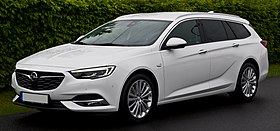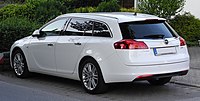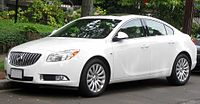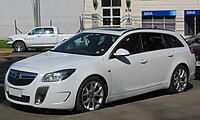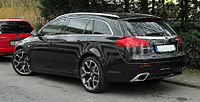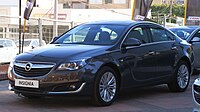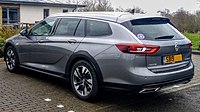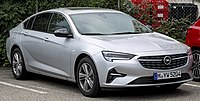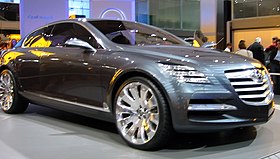
Opel Automobile GmbH, usually shortened to Opel, is a German automobile manufacturer which has been a subsidiary of Stellantis since 16 January 2021. It was owned by the American automaker General Motors from 1929 until 2017 and the PSA Group, a predecessor of Stellantis, from 2017 until 2021. Most of the Opel lineup is marketed under the Vauxhall Motors brand in the United Kingdom since the 1980s. Some Opel vehicles were badge-engineered in Australia under the Holden brand until 2020, in North America and China under the Buick, Saturn, and Cadillac brands, and in South America under the Chevrolet brand.
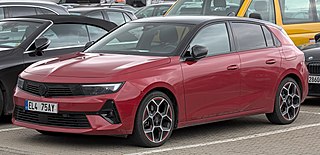
The Opel Astra is a compact car/small family car (C-segment) developed and produced by the German automaker Opel since 1991, currently at its sixth generation. It was first launched in September 1991 as a direct replacement to the Opel Kadett. As of 2022, the car slots between the smaller Corsa supermini and the larger Insignia large family car.
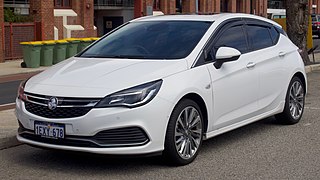
The Holden Astra is a small car formerly marketed by Holden. The first couple of generations of Astra were made only for Australia, and was a derivative of the locally produced Nissan Pulsar. With the Button car plan coming into effect, it was replaced by the Holden Nova, a rebadged Toyota Corolla.

The Opel Vectra is a mid-size car that was engineered and produced by the German automaker Opel from 1988 until 2010. Available in saloon, hatchback and estate body styles, the Vectra was also sold by the Vauxhall marque in the United Kingdom as the Vauxhall Cavalier from 1988 to 1995 and then as the Vauxhall Vectra from 1995 to 2008, and it was also sold by Holden in Australia as the Holden Vectra, by Chevrolet in Latin America as the Chevrolet Vectra.

The Vauxhall Cavalier is a large family car that was sold primarily in the United Kingdom by Vauxhall from 1975 to 1995. It was based on a succession of Opel designs throughout its production life, during which it was built in three incarnations. The first generation of Cavalier, launched in 1975 and produced until 1981, was Vauxhall's version of the General Motors 'U-Car' - essentially an Opel Ascona B/ Opel Manta with a few minor visual differences.

The Opel Zafira is a car manufactured and marketed across three generations between 1999 and 2019 by Opel. Based on the Opel Astra platform, it is developed to occupy the multi-purpose vehicle (MPV) segment.

The Opel Omega is an executive car engineered and manufactured by German automaker Opel between 1986 and 2004. The first generation, the Omega A (1986–1994), superseded the Opel Rekord. It was voted European Car of the Year for 1987, and was available as a saloon or estate. The second generation, the Omega B, was manufactured from 1994 to 2004.

The Buick Regal is a line of mid-size cars marketed by Buick since 1973. For nearly its entire production, the Regal has served as the premium mid-size/intermediate offering of the Buick product range. Introduced as a submodel of the Buick Century, the model line is currently in its sixth generation. From the 1970s to the 1990s, the Regal served as the Buick counterpart of the Pontiac Grand Prix and Oldsmobile Cutlass Supreme.

Epsilon is General Motors' mid-size front-wheel drive automobile platform. The architecture was a multi-division project of GM North America, Opel and Saab, and debuted in the 2002 Opel Vectra and 2003 Saab 9-3. Since this platform falls squarely in the center of the worldwide automobile market, GM plans to produce a great many Epsilon vehicles with over a dozen variations. As of 2005, it was GM's highest volume worldwide platform. Even after the dissolution of the GM/Fiat partnership, both companies retain the rights to continue developing Epsilon-derived models.
The Circle L is an automobile engine produced by GM Powertrain Poland in Poland. It is a 1.7 L; 102.9 cu in (1,686 cc) inline-four 16-valve turbocharged diesel engine originally designed by Isuzu but now owned by General Motors. The engine was produced in Europe by General Motors for use in the Opel, Vauxhall and Chevrolet vehicles and by Honda for use in the Civic compact car.

The Opel Meriva is a car manufactured and marketed by the German automaker Opel on its Corsa platform, from May 2003 until June 2017 across two generations. Described as a mini MPV, it was marketed as the Vauxhall Meriva in the United Kingdom, while in Latin America, the first generation model was marketed as the Chevrolet Meriva.

VXR is the branding for the high performance trim specification, used since 2004 for models in many of Vauxhall's car range in the United Kingdom. Holden has also used the VXR badge for some of its high-performance cars such as the Astra VXR, Insignia VXR, and the Commodore VXR.

Opel Performance Center (OPC) is a division of the German automobile manufacturer Opel, initially set up as a subsidiary in 1997. The main focus of OPC is the development of performance derivatives of the Opel range, such as the hot hatch Corsa OPC and Astra OPC.

The Family II is a straight-4 piston engine that was originally developed by Opel in the 1970s, debuting in 1981. Available in a wide range of cubic capacities ranging from 1598 to 2405 cc, it simultaneously replaced the Opel CIH and Vauxhall Slant-4 engines, and was GM Europe's core mid-sized powerplant design for much of the 1980s, and provided the basis for the later Ecotec series of engines in the 1990s.
General Motors New Zealand Limited, is a subsidiary of General Motors that distributes GM' motor vehicles, engines, components and parts in New Zealand.

The Opel Corsa is a supermini car engineered and produced by the German automobile manufacturer Opel since 1982. Throughout its existence, it has been sold under a variety of other brands owned by General Motors and also spawned various other derivatives.
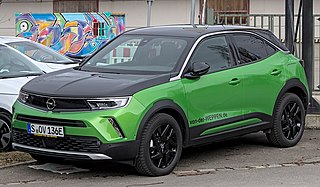
The Opel Mokka is a subcompact crossover SUV that has been produced by German automaker Opel since 2012. Sales began with the model year of 2013, at the end of 2012. The first generation was developed by GM Korea as the U200 Chevrolet Trax. The facelifted Opel Mokka was marketed as the Mokka X, before reverting to Mokka for the second generation. It is also sold under the Vauxhall brand in the United Kingdom. The Buick Encore sold in North America and in China was also derived from the Trax but the lines diverged after Opel became part of Stellantis.

The Opel Cascada is a four-passenger fabric-roof convertible, manufactured and marketed by Opel across a single generation for model years 2013-2019, prioritizing year-round touring comfort over sportiness.

The Holden Commodore (ZB) is the final generation of the Holden Commodore range produced by now-defunct Australian brand Holden from 2018 to 2020.
